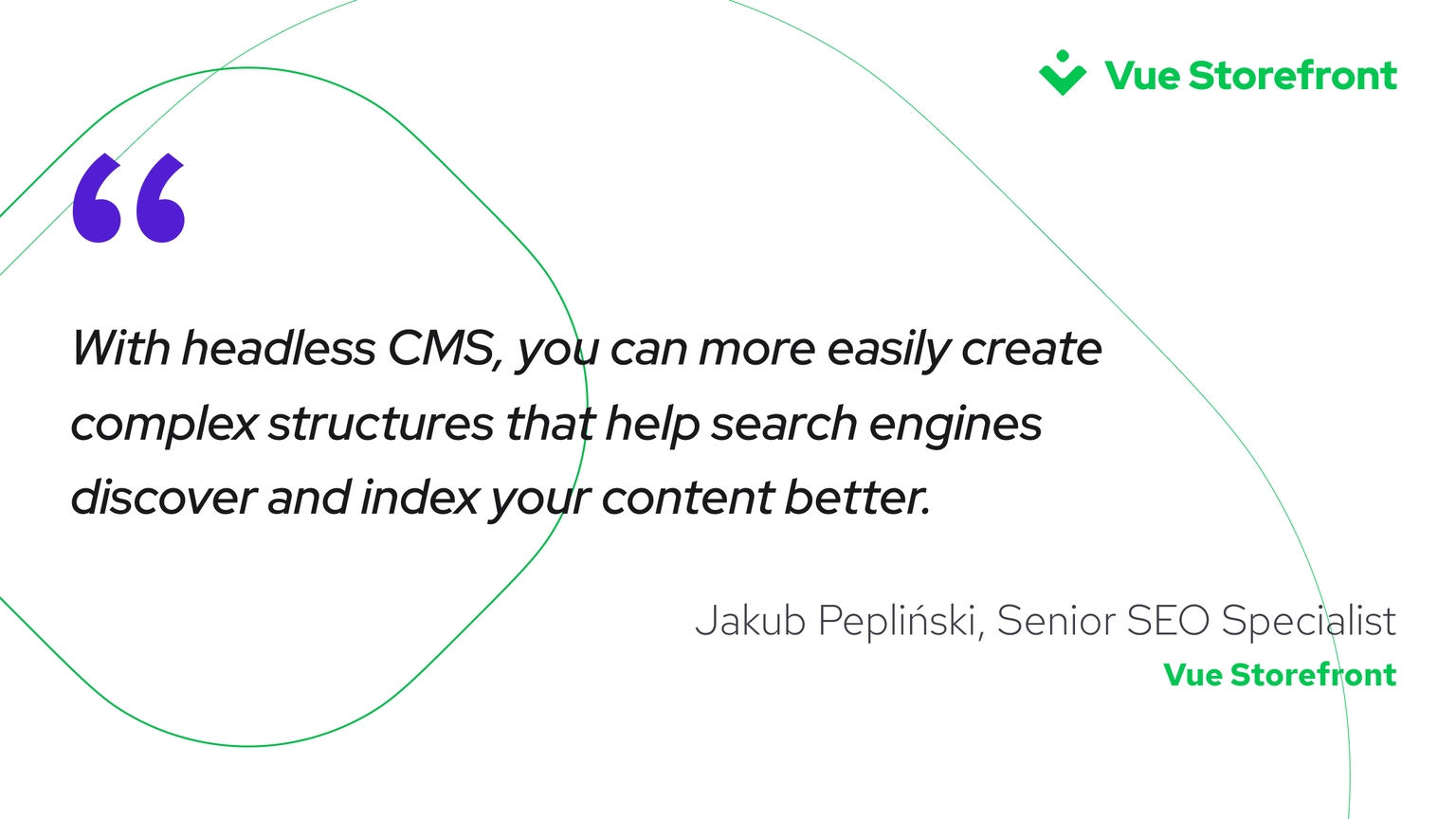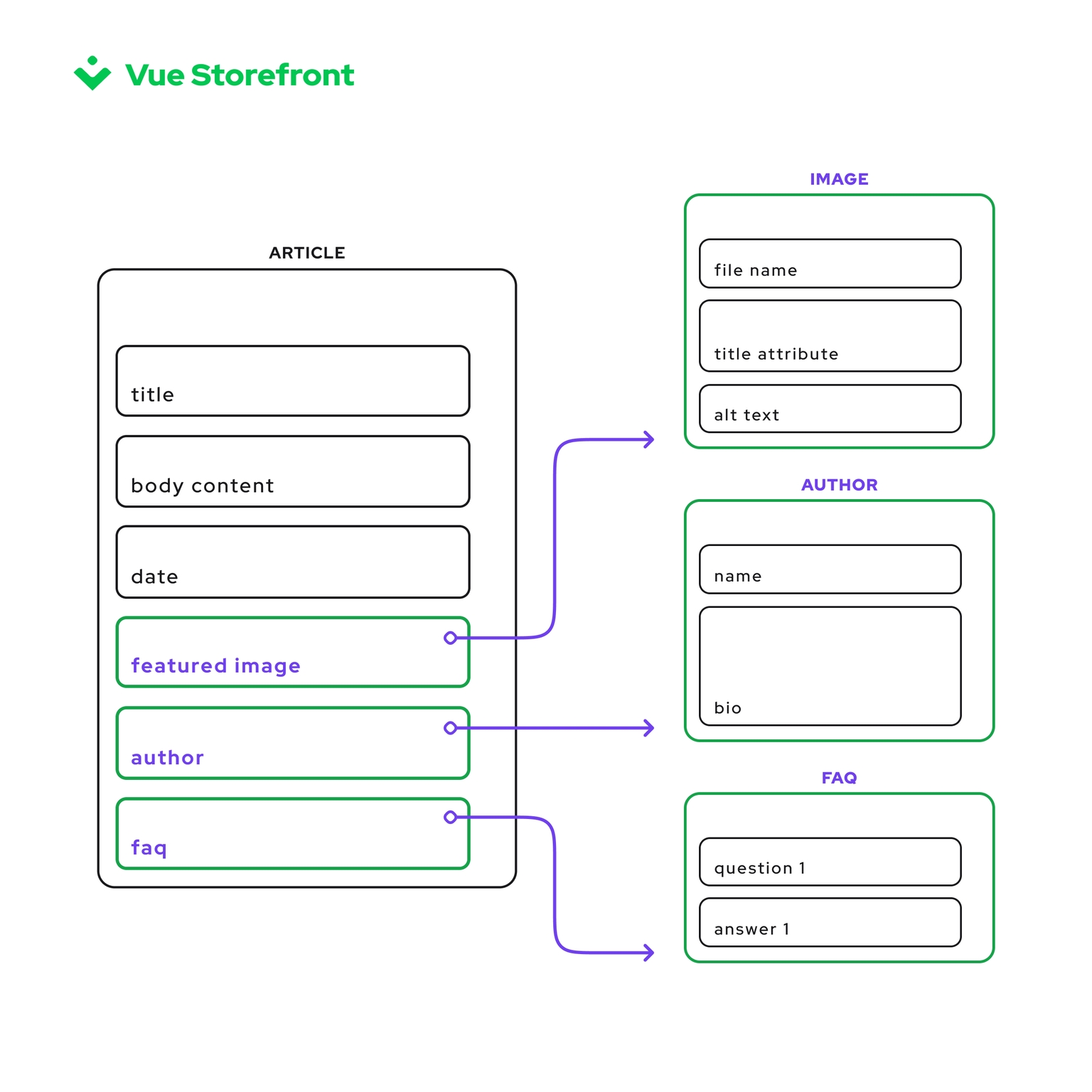So you are considering going headless. You might have read articles from industry thought-leaders about it being the next big thing in eCommerce. Or you went to an eCommerce conference where headless commerce was the second most-used term after omnichannel. Or perhaps you have just noticed that Linkedin is lately buzzing about headless commerce. Whatever the reason is, you most probably still have questions.
Since SEO is a crucial acquisition channel for most enterprise-scale eCommerce businesses, you might have reservations if you'll be able to retain your previous SEO efforts. You might even expect better SEO, and you wonder if that's possible.
I have already written about how headless commerce helps SEO in general, and now we will focus solely on the headless CMS part.
TL;DR: Major conclusions
SEO with headless CMS will require more effort during the development phase.
Although planning, design, and coding will take more resources than in the case of a traditional CMS, you will gain more flexibility in the end.
With headless CMS, you can more easily create complex structures that help search engines discover and index your content better.
You will need to perform content modeling for each type of page, and if an SEO specialist is involved in the process, chances for great SEO foundations grow.
Essentially, SEO principles stay the same regardless of your tech stack.
You must combine your headless CMS with an SEO-friendly frontend to achieve stunning SEO results.

This article will go through each conclusion and determine how to approach SEO for headless CMS.
Headless CMS and SEO definitions
First things first, before we go into the weeds of how to do SEO with a headless CMS, let’s lay down some definitions.
Headless CMS - Headless Content Management System – it’s software that stores, organizes, and delivers structured content via a RESTful API or GraphQL API to any device. Unlike a monolithic CMS, it is decoupled from the presentation layer (AKA the frontend).
SEO - Search Engine Optimization - a vast set of techniques with the primary goal of growing your presence in the organic search results of the search engines and driving organic traffic to your website. It stands on two pillars - the off-site SEO, primarily associated with link building, and the on-site, which, put simply, relates to the optimization of the content and particular technicalities, such as the page speed of your website.
Is SEO different when you use a headless CMS?
Principles for good SEO strategies are the same, whether you use a headless CMS or a traditional one. But there must be some SEO benefits if everyone is raving about it, right?
Headless CMS superiority for SEO is revealed in the ability and ease of implementing even the most inflated and complex structures and general flexibility to display the relevant content in the right places of your eCommerce.
If you look at the surface of any reasonably successful eCommerce, you will see that they took care of the SEO aspects similarly. Compared to the ones that are based on legacy CMSs like Drupal or WordPress, the ones using a headless CMS must have undertaken a bit more effort at the beginning during the design, planning, and coding phase.
Why is that? Well, let's take a look at how you even approach creating content with a headless CMS.
Basic SEO with headless CMS vs. legacy CMS
With traditional CMS, SEO professionals might have become a bit spoiled. Usually, all the features required to perform a basic on-page SEO are built in there, or there are ready plugins, alternatively.
With a headless CMS, SEO is not that straightforward, and you have to take a couple of additional steps back first. But it will be worth it - let’s see why.
On-page SEO
Whether we are talking about meta tags, SEO-friendly URLs, or image alt attributes, any traditional CMS should already have a dedicated text box for those.
In the case of a headless CMS it is a bit more complicated. You must scrutinize such elements and implement placeholders for them accordingly with your developers.
Examples of the SEO-related elements you will separately create consist of:
Meta tags
Title tag
Meta description
Crawling directives
Canonical tags
Follow/nofollow
Index/noindex
Structured data for the:
FAQ section
Product details
Reviews
And so on...
Content modeling
Let's say you want to migrate your eCommerce website to headless commerce (you might want to check out our eCommerce migration checklist).
One of the steps you will need to take is called Content Modeling.
It means you will build the outline for each content template structure you currently have in your store. It relates to the product, category, blog, etc. In headless CMS, they are usually referred to as entries.
Each entry will have various associated fields; examples of such fields are listed above.
So unlike a traditional CMS, where each of the pages’ elements is tightly associated with the page directly, in a headless CMS, you have an entry to which various elements are assigned. Thus, headless CMS can be treated as a content repository where you store all the content's elements, whether textual, numerical, or multimedia.

Surely content modeling should be a cross-team process, and undoubtedly an SEO specialist should be a crucial part of it. As a result, you should get an excellent foundation for future SEO endeavors.
It's worth mentioning that this process should be logical and intuitive for any SEO professional. We work with data structures daily (think of JSON-LD microdata).
Using a headless CMS to boost your SEO results
Building a content model for each of the page templates is one thing. However, other areas require your team's efforts during the design phase as well. And again, these aspects, although a bit more time-consuming, are the ones that can give you an edge.
Website structure and dependencies
One of the areas of eCommerce SEO that headless CMS can genuinely help you with is making your website loved by search engine crawlers.
Discoverability and crawlability are enormous topics, especially for medium and large sites. And not to say this is challenging.
If you are dealing with hundreds of thousands of products, you already know that getting all of them discovered and indexed by search engines can be difficult.
To solve this problem, you need to create product categorization that will be both intuitive and deep.
Categorization
Long-tail keywords have low search volumes, but they make up for 80% of user searches.
One of the great SEO tactics to help with discoverability is to implement categorization that will target a wide range of user queries.
Having products listed in well-targeted categories will help to resolve the discoverability and indexing issues.
With a headless CMS, you can easily create entries (pages) that will be collections of products that answer those vast ranges of user queries with content on separate pages.
There is also a bonus - customers will find exactly what they are looking for.
Supplemental content
Another clever way for ranking in search engines for more keywords is to create guides such as product comparisons or "top 20 X product" lists.
And guess what? Headless CMS can help here - extracting product information, such as prices, images, or features, into structured content pieces like those is a breeze with headless CMS. And yes, it can be highly beneficial for your SEO.
Recommended products
Upselling and cross-selling are well-known eCommerce sales techniques. But they can also be used to create internal links helpful for SEO. Having hyperlinks on a particular product page referring to other related products in a given category might give those products an additional SEO boost.
In its pure form, it is not something extraordinary, even for the legacy CMSs, but with a more advanced AI-driven personalization engine, the results will be much better.
The greatest thing about headless CMSs and composable commerce, in general, is the ability to connect to a wide range of tools through API, among which you will find a lot of personalization engines.
Validation rules
Another handy feature of practically any headless CMS is the ease of validation rules implementation.
What it means is that you might add rules that prevent you from inputting content that is not in line with basic SEO requirements. This means that content will not go through unless it passes certain conditions.
If you have ever received an SEO audit, you know that there are some best practices that SEO specialists usually expect to be implemented. To give you some examples:
Title tags should be no longer than 70 characters
Title tags should be different from the H1 header
Meta descriptions should be no longer than 160 characters
etc.
Imagine that a inexperienced marketer wanted to edit metadata in the CMS. If they tried to write a long sentence in the title tag field, they would get a prompt to correct it together with a short explanation. Pretty clever, right?
You must think of such mechanisms in the design and coding phase. And yes, it does require the collaboration of the developers and marketers.
But it is highly beneficial because once you have all the structures and validations in place, you are way ahead with your SEO and may focus on more in-depth tweaking and building domain authority.
Headless CMS is not the only element of the SEO puzzle
Incorporating a headless CMS can undoubtedly help to shape your website's SEO. Especially when an experienced SEO specialist gets involved in the early-stage planning.
You just need to remember that regardless of the website's architecture, you will need to ensure content quality and relevant keywords targeting.
What about the frontend?
Let's also not forget that headless CMS will be fetching all the content to be displayed on the frontend. And this is another big topic for SEO.
Even though you might have perfectly planned structures for your website, potential problems might appear on the presentation layer, and all the efforts you put into planning will be in vain. Your work within a headless CMS is crucial, but you cannot forget about the frontend.
You need a fast and mobile-optimized frontend architecture.
Some things to consider
When choosing your headless frontend technology, consider these things:
Server-side rendering (SSR) - You want all your content to be correctly rendered on the client side without any issues.
Mobile devices - In the mobile-first era, you should consider starting your design process from the mobile perspective.
Content Delivery Network (CDN) - If your operations are geographically scattered, and your customers are located in far states and/or countries, you should serve to diversify your hosting capabilities as well.
High loading speed -What contributes to the loading time of your website is the frontend layer mostly, and you should focus on this area if you want high conversion rates.
Progressive Web Apps (PWA) - If you are considering an eCommerce app, you might also look up the capabilities of the PWA which offers app-like features.
Alokai, a Frontend as a Service for composable commerce, provides all of the above and much more. If you want a headless frontend solution that will complement your headless CMS and not require building the presentation layer from scratch, Alokai might be the right fit for you.
Let's wrap up!
You now know that the same principles drive SEO for headless CMS as with any other legacy CMS.
As the main takeaway from the article, you should know that headless content management systems are more capable of SEO than traditional ones, especially with an experienced SEO specialist.
The primary benefits of headless CMS for SEO include:
Creating page templates with a proper SEO foundation implemented
Building complex structures and dependencies is easier
Reusing your content in a structured way in multiple ways
Creating validation rules that will safeguard the implementation of the basic SEO principles
Connecting to advanced AI personalization engines
Combining with an SEO-optimized frontend
Last but not least, remember that composable commerce means that headless CMS is only part of the equation, and to nail the SEO with this architecture, you will need to go beyond and make all the moving parts work for your success in organic search.



















